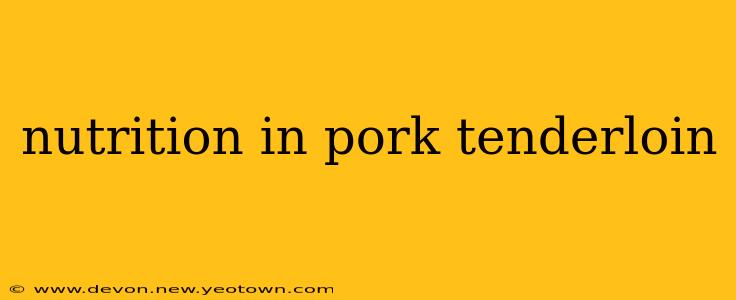Pork tenderloin. The name conjures images of elegant dinners, succulent roasts, and satisfying meals. But beyond its culinary appeal lies a nutritional profile that often surprises. This isn't your grandmother's tough, fatty pork chop; the tenderloin is a lean, protein-packed powerhouse brimming with essential nutrients. Let's embark on a culinary and nutritional journey to discover what makes pork tenderloin such a versatile and healthy choice.
Imagine this: a perfectly seared pork tenderloin, its delicate pink interior glistening, a testament to its lean composition and careful cooking. That's the picture we're painting today, one that goes beyond the simple pleasure of taste to explore the nutritional riches within.
What are the nutritional benefits of pork tenderloin?
Pork tenderloin boasts an impressive array of nutritional benefits. It's a stellar source of high-quality protein, essential for building and repairing tissues, supporting immune function, and maintaining a healthy metabolism. Beyond protein, it offers a good dose of essential vitamins and minerals, contributing to overall well-being. Specifically, it’s a decent source of thiamin (B1), niacin (B3), vitamin B6, and riboflavin (B2) – all crucial for energy production and nerve function. It also contributes to your daily intake of zinc, selenium, and phosphorus. These minerals play vital roles in everything from immune function to bone health.
Is pork tenderloin a good source of protein?
Absolutely! This is where pork tenderloin truly shines. A 3-ounce serving packs approximately 25-30 grams of protein, making it a fantastic option for individuals seeking to increase their protein intake, whether for muscle growth, weight management, or simply maintaining healthy bodily functions. This high protein content makes it a staple in many fitness-focused diets.
How much fat is in pork tenderloin?
Compared to other cuts of pork, the tenderloin is remarkably lean. While it does contain fat, the amount is significantly lower than in cuts like pork chops or ribs. The fat content contributes to the flavor and tenderness, but it’s not excessively high, making it a suitable choice for those watching their fat intake. However, the cooking method significantly impacts the final fat content; grilling or roasting is generally preferred over frying.
Is pork tenderloin healthy for weight loss?
The lean nature of pork tenderloin makes it a potentially valuable addition to a weight-loss diet. Its high protein content promotes satiety, helping you feel fuller for longer and potentially reducing overall calorie consumption. Remember that portion control and a balanced diet are still key for successful weight loss, but pork tenderloin can certainly play a supportive role.
What are the potential downsides of eating pork tenderloin?
While generally considered a healthy meat, pork tenderloin does have some potential drawbacks to consider. Individuals with specific dietary restrictions or allergies should always check the ingredients and source carefully. Also, like all meats, it’s important to cook it thoroughly to eliminate any potential foodborne illnesses. Finally, those watching their sodium intake should be mindful of added seasonings and marinades, which can significantly increase the sodium content.
How to prepare healthy pork tenderloin?
The beauty of pork tenderloin lies in its versatility. It can be grilled, roasted, pan-seared, or even slow-cooked, offering a wide range of flavor profiles. Opt for healthier cooking methods like grilling or roasting to minimize added fats. Experiment with herbs, spices, and citrus to create flavorful dishes without relying on heavy sauces or excessive sodium. Remember to use a meat thermometer to ensure it reaches an internal temperature of 145°F (63°C) for safe consumption.
In conclusion, pork tenderloin emerges as a nutritional winner, boasting impressive protein content, essential vitamins, and minerals, all while remaining a relatively lean meat option. By understanding its nutritional profile and employing smart cooking techniques, you can confidently incorporate this versatile protein into a healthy and balanced diet. So, next time you’re planning a meal, consider the subtle elegance and nutritional power of the pork tenderloin. Your body will thank you for it.

